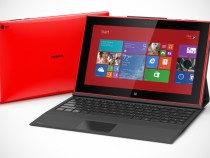
Nokia’s Lumia 2520 tablet will set you back $500 if you want to buy it flat out. AT&T is more than happy to sell you one at that price. Pick it up with a wireless contract, and AT&T will knock $100 off that sticker.
But pick up a Lumia 925, 1020, or 1520 at the same time, and the price of the Lumia 2520 drops to $200. That’s an incredible decline in cost. I confirmed with AT&T that the phone itself would be subsidized, but subject “to a second agreement,” or contract, so the deal only works if you are ready to pony up for two devices and requisite plans.
So, for the sum of $300 ($100 for the Lumia 925, $200 for the Lumia 2520), you can buy into the larger Windows ecosystem of Windows 8.x and Windows Phone. Why would Nokia do this? You can’t really view Nokia’s hardware choices as independent anymore, but for kicks, the reasons would be simple: Device volume is key to the health of the Windows (et al. form factors) platform. This means that Nokia does more than help its short-term revenue when it moves devices, it sets up its future by supporting the platform that it needs to stand upon.
But Nokia’s hardware division is now all but part of Microsoft’s hardware business, making the above all the more muddled in the best possible way. Let’s do this in pieces:
- Nokia lashes its tablet and smartphone hardware together, using carrier subsidies for consumers to bear the brunt of its margin pressure, to sell more units and help launch it into new hardware categories.
- Windows and Windows Phone benefit from larger unit volume, which brings more users, more downloads, and thus more developer satisfaction.
- Developers then in theory build more applications, which leads to happier customers, and therefore more customers, creating a virtuous loop.
- Microsoft buys Nokia’s hardware business, which it wants in order to sell more smartphones.
- Its new smartphone business is being used to sell tablets that compete with its own Surface line of devices.
So that’s fun, but the real issue here is that Microsoft (Nokia) has compiled a hardware package that it can presumably vend not at a loss that brings consumers onto its platforms (platform, depending on how precise you want to be), in twos instead of ones.
This is only a good for Microsoft if the Lumia 2520 is worth a damn. Early prognostications appear to be in its favor, though I can’t see why I’d prefer one to a Surface 2. But that doesn’t matter; Microsoft merely wants more RT devices sold, period. And that’s why the later points I think don’t matter to Microsoft: In the Game of Platforms, you either win or you become BlackBerry.
So to Microsoft, shaving Surface revenue in the short-term to bolster the somewhat tenuous Windows RT piece of the Windows empire probably makes sense.
Stepping back, moving units is Microsoft’s current problem, which is of course part of the same app problem that we endlessly discuss. The two are directly entertained. And Windows is bigger than Surface, meaning that it takes precedence.
Can Nokia (Microsoft) keep the deal up and not end up in a cold bath whilst ripping up hundred-dollar bills? (Margin pressure is a bitch). I don’t know, but I bet that Microsoft does. We’ll see if it keeps the gambit alive once the deal closes.
Read more : Nokia’s Tablet Gambit Will Drive Mobile Market Share For Microsoft If The Margins Hold Up

0 Responses
Stay in touch with the conversation, subscribe to the RSS feed for comments on this post.